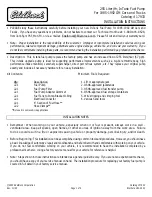
Driving in Rain and on Wet Roads
Rain and wet roads can reduce vehicle traction and
affect your ability to stop and accelerate. Always drive
slower in these types of driving conditions and avoid
driving through large puddles and deep
‐
standing or
flowing water.
{
WARNING:
Wet brakes can cause crashes. They might not
work as well in a quick stop and could cause
pulling to one side. You could lose control of the
vehicle.
After driving through a large puddle of water or a
car/vehicle wash, lightly apply the brake pedal
until the brakes work normally.
Flowing or rushing water creates strong forces.
Driving through flowing water could cause your
vehicle to be carried away. If this happens, you
and other vehicle occupants could drown. Do not
ignore police warnings and be very cautious about
trying to drive through flowing water.
Hydroplaning
Hydroplaning is dangerous. Water can build up under
your vehicle's tires so they actually ride on the water.
This can happen if the road is wet enough and you are
going fast enough. When your vehicle is hydroplaning, it
has little or no contact with the road.
There is no hard and fast rule about hydroplaning.
The best advice is to slow down when the road is wet.
Other Rainy Weather Tips
Besides slowing down, other wet weather driving tips
include:
.
Allow extra following distance.
.
Pass with caution.
.
Keep windshield wiping equipment in good shape.
.
Keep the windshield washer fluid reservoir filled.
.
Have good tires with proper tread depth. See
Tires
on page 6
‑
50
.
.
Turn off cruise control.
5-12
Summary of Contents for 2010 DTS
Page 6: ...2 NOTES vi...
Page 8: ...Instrument Panel Console Shift Model shown Column Shift Model similar 1 2...
Page 46: ...Put someone on it Get it up to speed Then stop the vehicle The rider does not stop 2 14...
Page 212: ...Instrument Panel Cluster United States version shown Canada similar 4 46...
Page 446: ...Engine Drive Belt Routing 4 6L V8 Engines 7 12...
















































